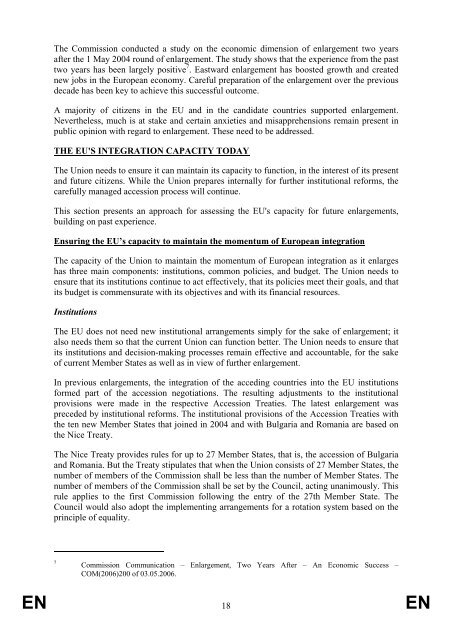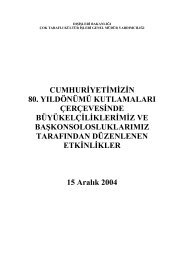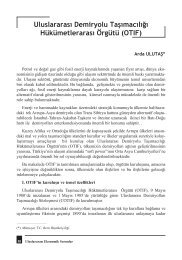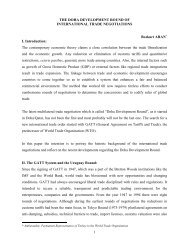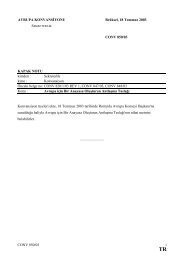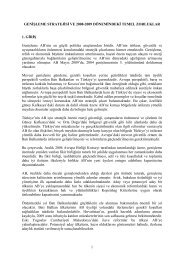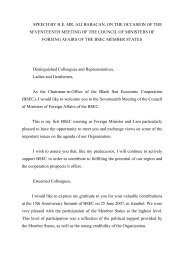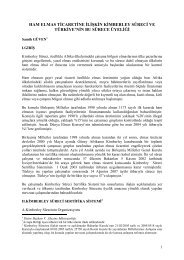Enlargement Strategy and Main Challenges 2006 - 2007
Enlargement Strategy and Main Challenges 2006 - 2007
Enlargement Strategy and Main Challenges 2006 - 2007
You also want an ePaper? Increase the reach of your titles
YUMPU automatically turns print PDFs into web optimized ePapers that Google loves.
The Commission conducted a study on the economic dimension of enlargement two years<br />
after the 1 May 2004 round of enlargement. The study shows that the experience from the past<br />
two years has been largely positive 7 . Eastward enlargement has boosted growth <strong>and</strong> created<br />
new jobs in the European economy. Careful preparation of the enlargement over the previous<br />
decade has been key to achieve this successful outcome.<br />
A majority of citizens in the EU <strong>and</strong> in the c<strong>and</strong>idate countries supported enlargement.<br />
Nevertheless, much is at stake <strong>and</strong> certain anxieties <strong>and</strong> misapprehensions remain present in<br />
public opinion with regard to enlargement. These need to be addressed.<br />
THE EU'S INTEGRATION CAPACITY TODAY<br />
The Union needs to ensure it can maintain its capacity to function, in the interest of its present<br />
<strong>and</strong> future citizens. While the Union prepares internally for further institutional reforms, the<br />
carefully managed accession process will continue.<br />
This section presents an approach for assessing the EU's capacity for future enlargements,<br />
building on past experience.<br />
Ensuring the EU’s capacity to maintain the momentum of European integration<br />
The capacity of the Union to maintain the momentum of European integration as it enlarges<br />
has three main components: institutions, common policies, <strong>and</strong> budget. The Union needs to<br />
ensure that its institutions continue to act effectively, that its policies meet their goals, <strong>and</strong> that<br />
its budget is commensurate with its objectives <strong>and</strong> with its financial resources.<br />
Institutions<br />
The EU does not need new institutional arrangements simply for the sake of enlargement; it<br />
also needs them so that the current Union can function better. The Union needs to ensure that<br />
its institutions <strong>and</strong> decision-making processes remain effective <strong>and</strong> accountable, for the sake<br />
of current Member States as well as in view of further enlargement.<br />
In previous enlargements, the integration of the acceding countries into the EU institutions<br />
formed part of the accession negotiations. The resulting adjustments to the institutional<br />
provisions were made in the respective Accession Treaties. The latest enlargement was<br />
preceded by institutional reforms. The institutional provisions of the Accession Treaties with<br />
the ten new Member States that joined in 2004 <strong>and</strong> with Bulgaria <strong>and</strong> Romania are based on<br />
the Nice Treaty.<br />
The Nice Treaty provides rules for up to 27 Member States, that is, the accession of Bulgaria<br />
<strong>and</strong> Romania. But the Treaty stipulates that when the Union consists of 27 Member States, the<br />
number of members of the Commission shall be less than the number of Member States. The<br />
number of members of the Commission shall be set by the Council, acting unanimously. This<br />
rule applies to the first Commission following the entry of the 27th Member State. The<br />
Council would also adopt the implementing arrangements for a rotation system based on the<br />
principle of equality.<br />
7<br />
Commission Communication – <strong>Enlargement</strong>, Two Years After – An Economic Success –<br />
COM(<strong>2006</strong>)200 of 03.05.<strong>2006</strong>.<br />
EN 18 EN


